Bears are large, powerful mammals belonging to the family Ursidae. There are 8 different surviving species of bears across the world with a conservation status ranging from vulnerable to least concern.
Bears can be found in many parts of the world, including North and South America, Europe, Asia, and the Arctic (the northern-most polar regions). Each species has adapted to its specific habitat.
Adult bears can range from about 2 to 10 feet (0.6 to 3 meters) in length, not including their tails, and can weigh up to 720 kg (1,600 pounds) or over a ton. They are characterized by a stocky and barrel-like build. They have short, strong legs that support their massive bodies.
Bears have small, rounded ears. Their sense of hearing is also well-developed. They easily detect sounds in their environment. Their eyes are small compared to the size of their heads, but still with a descent vision.

Their bodies are designed for both strength and agility. Bears are surprisingly agile for their size and can climb trees, swim, and move quickly when needed. Also the way their bodies are build provides them with the strength and stability necessary for activities such as foraging, hunting and defending themselves.
The color of bear fur can be from black, brown and blonde to white. The fur’s color usually corresponds to their habitat and serves as camouflage.
Bears have large, broad heads with strong jaws and teeth. Their jaws are good for crushing bones and tearing flesh for carnivorous species or grinding plant material for herbivorous ones. Their bite force is usually formidable.
Bears have strong, non-retractable claws. These claws are sharp and can be used for digging, climbing, catching prey, and tearing apart food. The length and curvature of the claws differ among species.
Their paws are large and powerful, with five toes equipped with sharp claws. The paws help distribute their weight and provide stability, especially when walking on terrains like snow, mud, or rocky surfaces. They can also use their paws for digging and manipulating objects.
Bears have relatively short tails that are often hidden within their fur. These tails are not very conspicuous and serve no purpose in their daily lives.
In many bear species, males (boars) tend to be larger and heavier than females (sows). This sexual dimorphism is more pronounced in some species than others.
Bears are opportunistic omnivores, they eat both plant and animal matter. What a bear eats primarily depends on its species, its geographic location, and the availability of food in its habitat. Their diet can include plants, fruits, insects, fish, and small mammals.
Usually gaining weight beforehand, most bears sleep fitfully through much of the winter, but they do not truly hibernate. Despite their bulk, most bears climb with ease and swim strongly.
Bears are among the longest-living mammals in the wild. Some can live up to 30 years, depending on the species and environmental factors.
Weird Facts About Bears
- Bears enter a state of hibernation during the winter months. During hibernation, bears do not eat, drink, urinate, or defecate. Instead, they recycle their own waste products to survive, which is a unique adaptation among mammals.
- Bears are known to mark their territory by rubbing their bodies against trees and scratching the bark. This behavior is called “scent-marking” and helps them communicate with other bears in the area.
- Polar bears are excellent swimmers and can cover long distances in the water. They are known to swim for hours or even days to find food or new ice floes.
- Bears have an incredible memory when it comes to food sources. They can remember the locations of food caches and return to them even after many months of hibernation.
- Bears have an incredible sense of smell, often referred to as the best among all terrestrial mammals. They can detect scents from miles away and use this ability to locate food, mates, and avoid potential dangers.
List of The 8 Bear Species Around The World
- Polar Bear (Ursus maritimus)
- Brown Bear (Ursus arctos)
- Black Bear (Ursus americanus)
- Giant Panda (Ailuropoda melanoleuca)
- Sloth Bear (Melursus ursinus)
- Malayan Sun Bear (Helarctos malayanus)
- Andean Bear (Tremarctos ornatus)
- Asian Black Bear (Ursus thibetanus)
- American Black Bear (Ursus americanus)
Species of Bear And Their Subspecies
Polar Bear (Ursus maritimus)

Polar bears are found in the Arctic region, including the Arctic Ocean, its surrounding seas, and the adjacent landmasses. They’re quite common throughout Greenland and Northern Canada. It is closely related to the brown bear, and the two species can interbreed.
The fur of this bear is white and enables it to blend in with their snowy surroundings. Beneath their white fur, polar bears have black skin. This can easily be notice by looking at their nose.
The polar bear is the largest extant species of bear and land carnivore. Adult males measure between 8 to 9 feet (2.4 to 2.7 meters) in body length. The Adult stand about 4.5 to 5 feet (1.4 to 1.5 meters) tall at the shoulder when on all fours.
Adult males usually weigh between 900 to 1,600 pounds (410 to 725 kilograms). Adult females are generally smaller and lighter, with weights ranging from 330 to 650 pounds (150 to 295 kilograms).
Polar bears are apex predators are carnivorous and mainly feed on seals, particularly ringed and bearded seals. They are excellent swimmers and can cover long distances in search of prey. Using their keen sense of smell to detect seals beneath the ice. They rely on sea ice as a platform for hunting seals. They often wait near breathing holes in the ice for seals to surface.
Although Polar Bears eat seals more than anything, they also feed on mammals as large as Beluga Whales and Walruses. They eat fish, birds and will even feed on kelp.
Polar bears are solitary animals and have a low reproductive rate. Females give birth to one to three cubs after a gestation period of about 8 months. Cubs are born blind and helpless and rely on their mother’s milk for nourishment. The mother cares for her cubs for about 2.5 years.
With only 23,000 left of the species, Polar bears are classified as vulnerable by the International Union for Conservation of Nature (IUCN). Their main threat is climate change, which leads to the reduction of sea ice, disrupting their hunting habits.
Polar bears hold a special place in the cultures of many indigenous Arctic peoples. They are featured prominently in myths, stories and art.
Brown Bear (Ursus arctos)
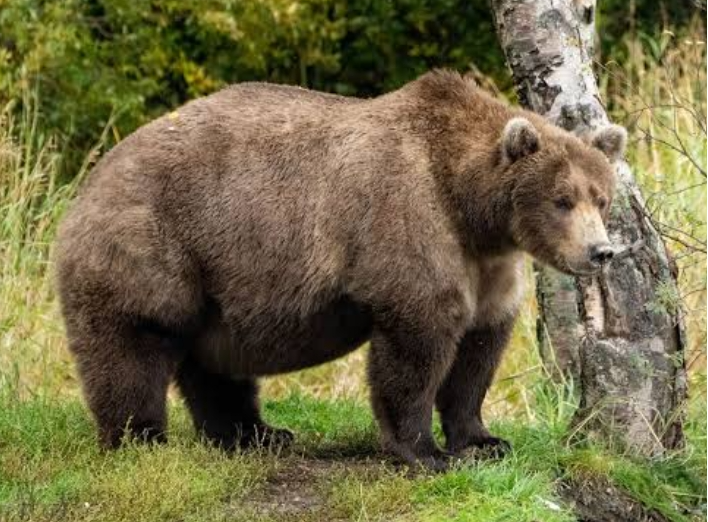
The brown bear (Ursus arctos) is one of the most widely distributed bear species in the world and can be found across North America, Europe, and Asia. Brown bears are known by various names depending on their location, including grizzly bears in North America, Eurasian brown bears in Europe and Asia, and Kodiak bears in the Kodiak Archipelago of Alaska.
Adult males weigh between 600 to 1,500 pounds (270 to 680 kilograms) and measure 7 to 10 feet (2.1 to 3 meters) in length. Females are generally smaller, weighing between 300 to 700 pounds (135 to 315 kilograms). A common feature of brown bears, particularly in males, is the shoulder hump.
While brown is the most common color, some individuals may have a more reddish or even silver-tipped appearance. They’re very adaptable. Their habitat includes the desert, wetlands, grassland, forest, and shrubland.
Brown bears are generally solitary animals, with adults maintaining large home ranges. They are territorial and will defend their territory, especially during the mating season.
This bears have eat plant material like berries, roots, and grasses, as well as animal prey such as fish, small mammals, calves of many hoofed animals, and carrion.
They usually mate in the spring, and after a gestation period of about 6 to 7 months, females give birth to 1 to 3 cubs. At birth a cub weighs less than 1 kg (2.2 pounds).
Brown bears has faced local extinctions across its wide range, it remains listed as a least concern species by the International Union for Conservation of Nature (IUCN) with a total population of more than 200,000 individuals as of 2023.
Except in some southern areas, this bears retire to dens in winter; they accumulate large amounts of fat during late summer and autumn.
Brown bears living in close proximity to humans are often regarded as pests because of the animals’ attraction to human foods. Their large size and relatively aggressive disposition can unsettle people who come in contact with them, and brown bears that frequent human settlements are sometimes killed by landowners and government officials.
The subspecies of the Brown Bear include:
- Tibetan Blue Bear (Ursus arctos pruinosus)
- Marsican Brown Bear (Ursus arctos arctos)
- California Grizzly Bear (Ursus arctos californicus)
- Grizzly bear (Ursus arctos horribilis)
- Alaskan Grizzly Bear (Ursus arctos alascensis)
- Kamchatka Brown Bear (Ursus arctos beringianus)
- East Siberian Brown Bear (Ursus arctos collaris)
- Atlas Bear (Ursus arctos crowtheri)
- Dall Island Brown Bear (Ursus arctos dalli)
- Alaska Peninsula Brown Bear (Ursus arctos gyas)
- Himalayan Brown Bear (Ursus arctos isabellinus)
- Ussuri Brown Bear (Ursus arctos lasiotus)
- Kodiak Bear (Ursus arctos middendorfii)
- Stickeen Brown Bear (Ursus arctos stikeenensis)
- Syrian Brown Bear (Ursus arctos syriacus)
- ABC Islands Bear (Ursus arctos sitkensis)
Asian Black Bear (Ursus thibetanus)

The Asiatic Black Bear is a medium-sized bear species found mainly in Asia. This bear species is also known by other names, including the Asian Black Bear, Moon Bear (due to the white crescent-shaped patch on its chest), and the Himalayan Black Bear. They can be found from the North of India, Indonesia, Japan to China.
These type of Bears are adaptable and can inhabit, Temperate and tropical forests, Montane regions, Bamboo forests, Alpine meadows and Scrubland.
When standing on all four legs, these bears measure about 2 to 3.3 feet (0.6 to 1 meter) in height at the shoulder. Adult males weigh between 220 to 440 pounds (100 to 200 kilograms) or even more, with some exceptionally large individuals exceeding 600 pounds (272 kilograms). Females are smaller and lighter, with weights of 110 to 275 pounds (50 to 125 kilograms).
Their fur is dense and appears black, although it can sometimes appear brownish or bluish in certain lighting conditions. The characteristic white or cream-colored crescent-shaped patch on their chest is the main identifying feature of this bear.
The Asiatic black bear is omnivorous, eating insects, fruit, nuts, bees and honey, small mammals, vegetation, including bamboo shoots, birds as well as carrion. Also roots and tubers. It will occasionally attack domestic animals.
Asiatic Black Bears are nocturnal in nature. They are most active during the night and rest during the day in dens or other sheltered locations. They are solitary animals, although they may come together in small groups occasionally, during the breeding season or at abundant food sources.
Males and females become sexually mature between ages three and four. Mating occurs between June and October, and pregnancies typically produce two cubs some seven to eight months later. After weaning, the young remain with the mother for as long as three years. Asiatic black bears may live as long as 25 years in the wild and up to 39 years in captivity.
The subspecies of the Asian Black Bear include:
- Formosan Black Bear (Ursus thibetanus formosanus)
- Japanese Black Bear (Ursus thibetanus japonicus)
- Indochinese Black Bear (Ursus thibetanus mupinensis)
- Balochistan Black Bear (Ursus thibetanus gedrosianus)
- Himalayan Black Bear (Ursus thibetanus laniger)
- Ussuri Black Bear (Ursus thibetanus ussuricus)
- Tibetan Black Bear (Ursus thibetanus thibetanus)
Sloth Bear (Melursus ursinus)
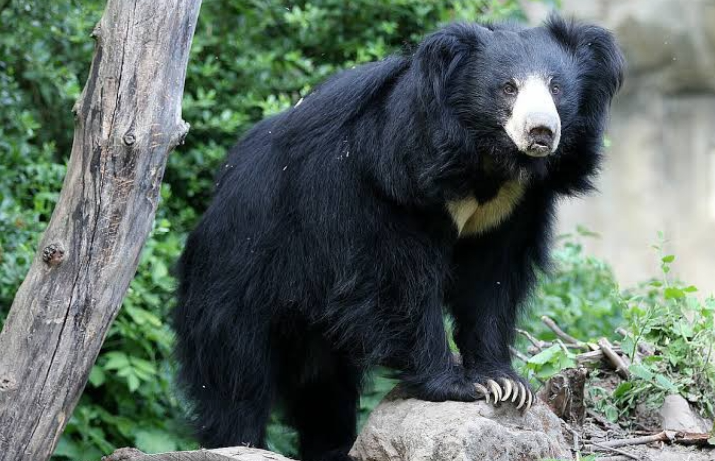
The sloth bear (Melursus ursinus) is a unique species of bear native to the Indian subcontinent. It is found in India, Sri Lanka, Nepal and Bhutan. It prefers forested habitats, including dry and moist deciduous forests, grasslands, and scrublands. These bears are usually associated with hilly or rocky terrain.
Adult male sloth bears weigh between 120 to 140 kilograms (265 to 310 pounds), although some individuals can be larger. Female sloth bears are slightly smaller, usually weighing less than males. Its length from the tip of its nose to the tip of its tail is usually around 1.4 to 1.8 meters (4.6 to 5.9 feet). It stand about 60 to 90 centimeters (2 to 3 feet) tall at the shoulder.
You can easily recognize sloth bears from their shaggy, black fur and white “V” or “Y” shape on their chest. Their long, flexible snout is another unique feature is another key identification feature. Their snout is devoid of the typical bear’s sharp incisors and canines, instead having molars adapted for grinding food.
Sloth bears are nocturnal. They are most active during the night. Their diet mainly consists of insects, particularly termites and ants. They use their powerful claws to break open termite mounds and ant nests and then use their snout to suck up the insects.
These bears are solitary in nature, although mothers will stay with their cubs for an extended period. They are not territorial and their home range can vary widely.
Sloth bears breed during spring and early summer and give birth near the beginning of winter. When their territories are encroached upon by humans, they sometimes attack them. They are also consume fruits, flowers, honey, and occasionally small vertebrates like birds and mammals.
These bears are listed as vulnerable on the International Union for Conservation of Nature (IUCN) Red List of Threatened Species. Currently, conservation efforts include the protection of their natural habitats, efforts to reduce human-bear conflicts, and anti-poaching measures.
Sloth bears have a rich cultural and mythological importance in some parts of India. They are associated with deities and legends, and their appearance has inspired stories and beliefs in local communities.
Giant panda Bear (Ailuropoda melanoleuca)
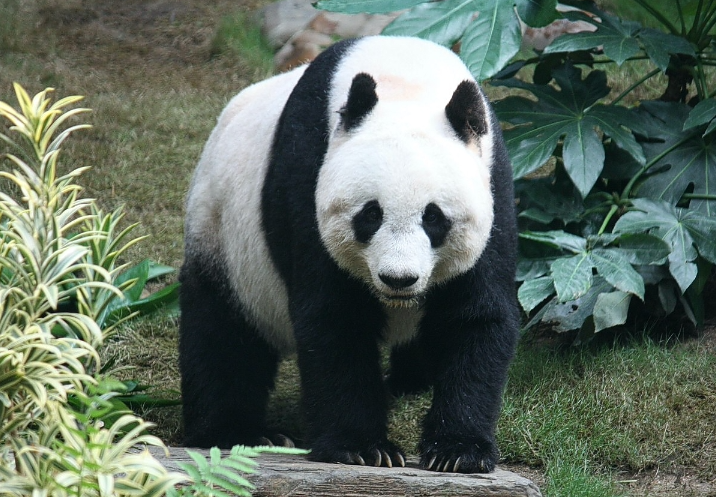
The giant panda (Ailuropoda melanoleuca) sometimes called a panda bear or simply panda, is one of the most beloved animals in the world. It is native to China and are mainly found in the mountainous regions of Sichuan, Shaanxi, and Gansu provinces.
Giant pandas live in broadleaf and coniferous forests with a dense understory of bamboo, at elevations between 5,000 and 10,000 feet with torrential rains or dense mist throughout the year.
Giant panda are known for their gentle and endearing demeanor. They are characterized by bold black-and-white coat and rotund body. For decades, animal experts did not know how to classify them, since they thought these bears were close to the Red Panda.
Although scientists do not know why these unusual bears are black and white, some speculate that the bold coloring helps them blend into their snowy mountainous habitat.
Adult giant pandas measure about 1.2 to 1.9 meters (4 to 6 feet) in length and stand between 60 to 90 centimeters (2 to 3 feet) tall at the shoulder. Males are larger than females, with males weighing between 85 to 125 kilograms (187 to 276 pounds), while females weigh slightly less. Females rarely reach 220 pounds (104 kilograms).
Giant pandas are solitary creatures, and they tend to avoid direct confrontations with each other. They have a large home range and mark their territories with scent markings. They are usually active during the early morning and late evening, with much of their daytime spent resting or sleeping.
Giant pandas are herbivores, with bamboo making up over 99% of their diet. In the wild they occasionally eat other grasses, wild tubers, or even meat in the form of birds, rodents, or carrion. In captivity, they may receive honey, eggs, fish, yams, shrub leaves, oranges, or bananas along with specially prepared food.
Giant pandas are not highly prolific breeders. They have a brief mating season in the spring, in March or April. The gestation period for giant pandas lasts about 95 to 160 days. Female pandas usually give birth to one or occasionally two cubs.
Panda cubs are born extremely small and vulnerable, weighing only about 90 to 130 grams (3 to 4.5 ounces) at birth. The mother cares for her cubs exclusively for several months before they start to eat bamboo.
According to The Smithsonian’s National Zoo and Conservation Biology Institute a leader in giant panda conservation. As few as 1,864 giant pandas live in their native habitat, while another 600 pandas live in zoos and breeding centers around the world.
In 2016, it was reclassified on the IUCN Red List from “endangered” to “vulnerable”, affirming decade-long efforts to save the panda. In July 2021, Chinese authorities also reclassified the giant panda as vulnerable.
The giant panda has often served as China’s national symbol, appeared on Chinese Gold Panda coins since 1982 and as one of the five Fuwa mascots of the 2008 Summer Olympics.
Spectacled Bear or Andean Bear (Tremarctos ornatus)
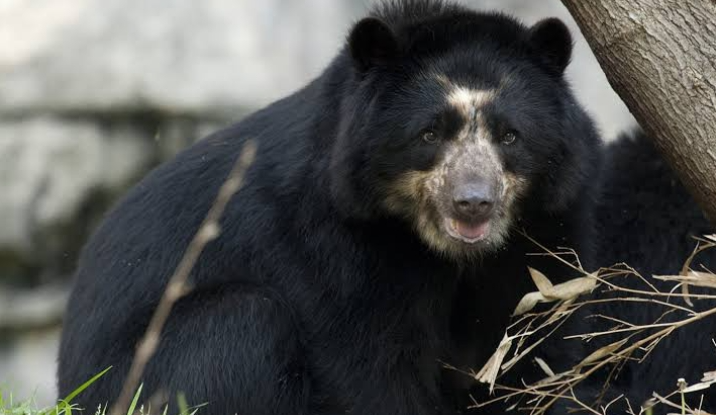
The spectacled bear, also known as the South American bear, Andean bear or mountain bear and locally as jukumari, is native to the Andes Mountains in northern and western South America.
It is the only bear species found in South America. It found in countries like Colombia, Ecuador, Peru, Bolivia, and parts of Venezuela. It inhabit cloud forests, montane forests, and páramo (high-altitude grasslands).
It can easily be identified from its facial markings that give it the appearance of wearing “spectacles” or eyeglasses. They actually have a shaggy black or dark brown coat with a whitish-yellowish patch across their face and throat. Compared to other living bears, this species has a more rounded face with a relatively short and broad snout.
Spectacled bears measure around 5 to 6 feet (1.5 to 1.8 meters) in length from their nose to the tip of their tail. Adult males are larger than females, with males weighing between 220 to 440 pounds (100 to 200 kilograms). Females weigh between 130 to 330 pounds (60 to 150 kilograms). They also stand at about 2.6 to 3 feet (80 to 90 centimeters) tall at the shoulder.
This bears are solitary animals. They don’t like to compete with each other. They tend to isolate themselves instead. In areas of abundance, they will live in small groups.
They are also good climbers and can be found in trees, foraging for food. Their diet mainly consists of plant material, such as fruits, leaves, and bamboo shoots. They will also eat insects, small mammals, and occasionally carrion.

Female give birth to one to three cubs at a time, usually in a hidden den. Cubs stay with their mother for an extended period.
The spectacled bear’s sense of smell is extremely sensitive. They can perceive from the ground when a tree is loaded with ripe fruit. On the other hand, their hearing is moderate and their vision is short.
The spectacled bear is classified as Vulnerable by the International Union for Conservation of Nature (IUCN). Habitat loss due to deforestation, fragmentation, and illegal hunting pose significant threats to their population.
In some Andean cultures, this bear is considered a symbol of strength and power. It features prominently in indigenous folklore and is sometimes seen as a sacred animal.
Malayan Sun Bear (Helarctos malayanus)

The Malayan Sun Bear is one of the smallest bear species in the world and is commonly found in Southeast Asia, particularly Malaysia, Indonesia, Thailand, Myanmar, Laos, Cambodia and Vietnam. They are well adapted to the lowland rainforests but can also be found in montane forests at higher elevations.
The Male bears weigh between 50 to 65 kilograms (110 to 143 pounds). Females are slightly smaller, with an average weight ranging from 30 to 45 kilograms (66 to 99 pounds). The total body length of this bear is usually from 120 to 150 centimeters (47 to 59 inches) whereas its shoulder height is about 60 to 75 centimeters (24 to 30 inches).
Their fur is short, sleek, and jet black in color, with a yellow or orange crescent-shaped marking on their chest. This marking gives them the appearance of having a “sun” on their chest, hence the name “Sun Bear.” You can even easily identify this bear from its face, which is hairless with a contrasting pattern of white or pale yellow markings around its eyes and muzzle.
Sun bear is mainly active during the day, though nocturnality might be more common in areas frequented by humans. They usually tend to remain solitary, but sometimes occur in twos (such as a mother and her cub). They do not seem to hibernate, possibly because food resources are available the whole year throughout the range.
Their diet is quite diverse and consists mainly of fruits, insects, small vertebrates and honey. They are excellent climbers and use their sharp claws to access insects and honey in tree cavities. These bears are usually known for their love for honey. They have an exceptionally long tongue, which they use to extract honey from beehives.
Sun Bears have a low reproductive rate, with females giving birth to usually one or two cubs after a gestation period of about 95 to 170 days. Cubs are born blind and hairless and are entirely dependent on their mother for the first few months of their lives.
These bears are often hunted for their body parts, which are used in traditional medicine and their cubs are sometimes captured for the illegal pet trade. The global population is estimated to have declined by 35% since the 1990s. The International Union for Conservation of Nature (IUCN) Red List put this species as vulnerable category.
There are two subspecies of sun bear. They include:
- Helarctos malayanus euryspilus: This subspecies, known as the Bornean Sun Bear, is native to the island of Borneo, which is divided among the countries of Malaysia, Indonesia, and Brunei.
- Helarctos malayanus malayanus: This subspecies, commonly referred to as the Malayan Sun Bear or the Southeast Asian Sun Bear, and is native to Malaysia, Thailand, Myanmar, Cambodia, Laos, Vietnam and parts of Indonesia.
North American Black Bear (Ursus americanus)
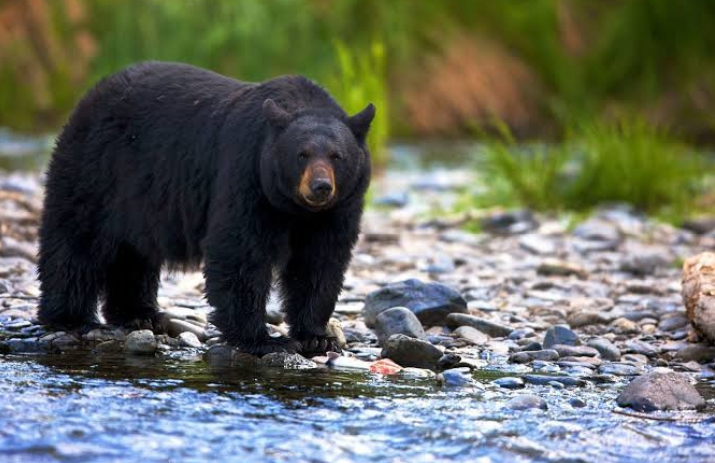
The American black bear, also known as the black bear, is a species of medium-sized bear endemic to North America. It is the continent’s smallest and most widely distributed bear species. They can be found throughout northern Canada and Alaska to the southern regions of Mexico. They are very adaptable and can live in forests, swamps, mountains and even urban areas.
The most common color for North American Black Bears as their name suggests, is black. However, they can also be brown, cinnamon or even blond. The rarest color phase is the white or cream-colored bears known as Kermode bears or “spirit bears.” These white bears are mainly found in parts of British Columbia, Canada.
The fur of this bear is dense and soft. In the winter, their fur is longer and thicker to provide insulation against the cold. During the summer, it may appear shorter and sleeker.
Black bears are smaller in size compared to other bear species, like grizzly bears. Adult males weigh between 200 to 600 pounds (90 to 270 kilograms), while adult females are smaller, usually weighing about 90 to 400 pounds (40 to 180 kilograms).
Their diet largely includes plant matter like berries, nuts, roots, tender young shoots and grasses. They also opportunistically hunt small mammals. Their prey includes fish, particularly during salmon runs, as well as small mammals like rodents, deer fawns, carrion and occasionally birds.
North American Black Bears are solitary animals, except during mating season and when females have cubs. They are excellent climbers and swimmers and use these skills to escape predators or find food. They are also known for their opportunistic behavior, often seeking out human food sources in populated areas.
Black bears are one of the few species that truly hibernate. During the winter months, they enter a state of torpor where their metabolic rate drops. They don’t eat, drink, or urinate during this period, which can last several months, depending on the climate.
Mating for these bears occur in late spring to early summer and cubs are born in January or February, during hibernation. A litter can consist of one to four cubs, with the mother caring for and protecting them until they are old enough to venture on their own, usually at around 1.5 to 2.5 years of age.
North American Black Bears have a stable population overall and are not currently listed as endangered by the International Union for Conservation of Nature (IUCN). They have a widespread distribution and a large population estimated to be twice that of all other bear species combined.
Subspecies of North American Black Bear:
- Kermode Bear (Ursus americanus kermodei): Also known as the “Spirit Bear,” Kermode bears are found to the coastal rainforests of British Columbia, Canada, particularly in the Great Bear Rainforest.
- Olympic Black Bear (Ursus americanus altifrontalis): Inhabit the Olympic Peninsula of Washington State.
- New Mexico Black Bear (Ursus americanus amblyceps): Found in the southwestern United States and northern Mexico.
- California Black Bear (Ursus americanus californiensis): Found throughout the state of California.
- Eastern Black Bear (Ursus americanus americanus): This subspecies is the most widespread and can be found throughout the eastern United States and Canada.
- Cinnamon Bear (Ursus americanus cinnamonum): Also known as cinnamon-phase black bears, these individuals can be found in various parts of North America.
- Haida Gwaii Black Bear (Ursus americanus carlottae): Inhabit the Haida Gwaii archipelago off the coast of British Columbia, Canada.
- East Mexican Black Bear (Ursus americanus eremicus): Found in eastern Mexico.
- Glacier Bear (Ursus americanus emmonsii): Glacier Bears, also known as Blue Bears, are found in southeastern Alaska. Their habitat includes coastal rainforests and glacier-fed river valleys.
- Newfoundland Black Bear (Ursus americanus hamiltoni): These bears are native to Newfoundland and the southern coast of Labrador in eastern Canada.
- Florida Black Bear (Ursus americanus floridanus): Florida Black Bears inhabit the forests and swamps of Florida.
- Vancouver Island Black Bear (Ursus americanus vancouveri): These bears are native to Vancouver Island in British Columbia, Canada.
- Kenai Black Bear (Ursus americanus perniger): Inhabiting the Kenai Peninsula in Alaska.
- Louisiana Black Bear (Ursus americanus luteolus): Inhabit bottomland hardwood forests and swamps in the Lower Mississippi Alluvial Valley.
- West Mexican Black Bear (Ursus americanus machetes): Found in western Mexico.
- Dall Island Black Bear (Ursus americanus pugnax): These bears inhabit Dall Island in southeastern Alaska.